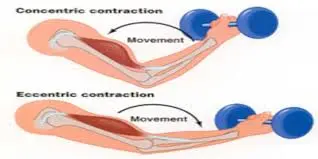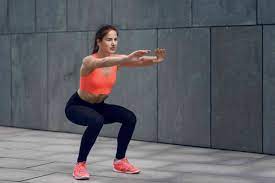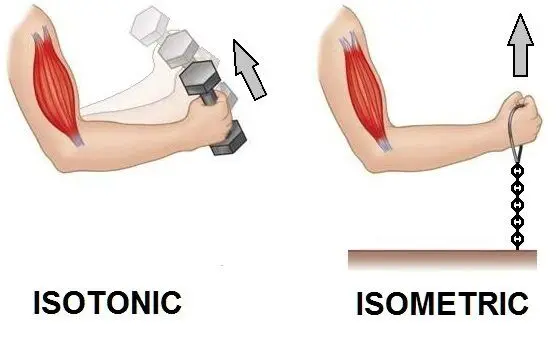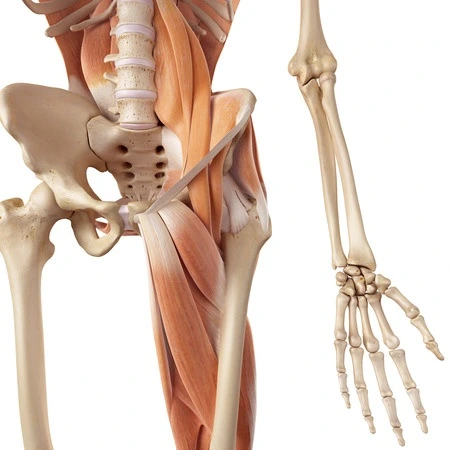Isotonic exercise
Table of Contents
What is Isotonic exercise?
Isotonic exercise is also called dynamic exercise. It is an exercise in which the force applied to muscle carries the same during the whole range of motion while the length of opposite side muscles alter as when we contract any muscle shortens against a continuous weight, for instance when we lift weights for some conditioning of a muscle group.
Isotonic arises from the Greek word “iso which means equal and tonos means tone. whole meaning maintaining equal muscle tone. The muscle maintains a constant tone while shortening during isotonic exercise. On another side, isometric exercise also called static exercise, is when muscle contract without any movement of the involved parts of the body.
What are some types of isotonic exercises?

Aerobic exercises just like walking, running, hiking, swimming, skiing, and dancing are all included in isotonic exercises. Moreover, resistance training exercises include motion, like squats, pushups, pull-ups, bench presses, deadlifts, and bicep curls. Also, daily activities like house cleaning, lawn cutting, and gardening also give isotonic exercise. Isotonic exercise would be an interesting and not boring activity. It could be an adventure and a way to do it every day while getting the necessary exercise.

There are two main types of contraction that occur in isotonic exercise:
• Concentric contractions: when your muscle shortens as you get over the force of a weight
• Eccentric contractions: when your muscle lengthens while being resisted by the force of a weight
For example, when you are doing a bicep curl exercise you lift the weight towards your shoulder at that time your bicep muscles are performing a concentric contraction. When you bring the weight downward, the contraction changes to eccentric contraction. Your muscles are resisting the load of the weight during the whole range of motion.
During a concentric contraction, the muscular force decreases the resistance while in an eccentric contraction, the resistance is much higher to get over by muscle force. This results in a lengthening of the muscle which is supposed to carry the load.
For instance, an eccentric contraction would attempt to do bicep curls with a heavy weight that is almost impossible to get off the ground. The majority of all workout which helps to get a fit body are done with weights that carry out isotonic movements, mainly the concentric kind of exercise
The Benefits of isotonic exercise
Isotonic exercise is very helpful in strengthening your cardiovascular system, as it results in raising the use of oxygen, heart rate, stroke volume, cardiac output, and muscle endurance while decreasing the risk of heart disease. Isotonic exercise also enhances the density of bone just because of the consistent load, which results in the formation of new bone.
If a person has Stronger bones which means he will be less at risk of breaking bones. Isotonic exercise also helps to reduce calories and enhance our health in means of, controlling cholesterol and blood sugar levels. Moreover, it also helps in building bigger, stronger muscles, helping you to prevent injury which can be caused due to strains, sprains, fractures, and falls. The more you practice isotonic exercise, it will get very easy for you.
The advantages of isotonic training.
Isotonic exercises are famous just because neither of them does need any special objects or anything you can not find in a general gym. moreover, many isotonic exercises are natural and intuitional for many people to practice, which means they can convert well into motion that you perform daily outside of the gym. They also work on the focused joint’s whole range of motion.
While isotonic instinctive exercises be likely to be, it is very necessary to produce proper technique. Most people never find the smaller points of finishing these exercises.
1. Increased muscle strength and endurance: Isotonic exercise involves performing movements that involve constant resistance throughout the range of motion. This type of exercise is effective in building muscle strength and endurance as it requires the muscles to work against resistance, leading to hypertrophy (muscle growth) and increased muscular endurance. This can be particularly beneficial for athletes who need to perform repetitive movements over a prolonged period.
2. Improved joint mobility: Isotonic exercises involve moving joints through a full range of motion, which can help to improve joint mobility and flexibility. This can be particularly beneficial for people who have stiff or sore joints, as it can help to reduce pain and increase range of motion. Improved joint mobility can also help to prevent injuries and improve overall athletic performance.
3. Enhanced cardiac health: Isotonic exercise can help to improve cardiovascular health by increasing heart rate and blood flow. When you perform isotonic exercises, your heart has to work harder to pump blood to your muscles, which can help to improve cardiovascular fitness over time. This can result in a reduced risk of heart disease, stroke, and many other cardiovascular conditions.
4. Weight management: Isotonic exercise can help with weight management by burning calories and building lean muscle mass. When you perform isotonic exercises, you are using energy (calories) to power your muscles. Over time, this can lead to an increase in lean muscle mass, which can help to boost metabolism and burn more calories even when you are at rest. This can be especially beneficial for people who aim to reduce weight or maintain a healthy weight.
5. Improved bone density: Isotonic exercise can also help to improve bone density, which is important for preventing osteoporosis and other bone-related conditions. When you perform isotonic exercises, the stress placed on your bones helps to stimulate bone growth and increase bone density.
In conclusion, isotonic exercise offers numerous benefits for overall health and fitness. It can help to improve muscle strength and endurance, joint mobility, cardiovascular health, weight management, and bone density. By incorporating isotonic exercises into your regular workout routine, you can improve your physical fitness and overall well-being.
Disadvantages of Isotonic exercise
While isotonic exercise has many benefits, there are also some potential disadvantages to consider:
1. Risk of injury: Isotonic exercises can put a lot of stress on the muscles and joints, which can increase the risk of injury if proper form and technique are not used. Overuse injuries such as tendinitis and muscle strains can also occur if the same muscles are worked too frequently without adequate rest and recovery time.
2. Limited muscle activation: Isotonic exercises typically only work for one or a few muscle groups at a time, which can limit overall muscle activation and development. This can be a disadvantage for people looking to build full-body strength and endurance.
3. Plateauing: Over time, the body can adapt to isotonic exercises, leading to a plateau in progress. This means that after a certain point, it may be difficult to continue making gains in muscle strength, endurance, or other fitness goals without changing up the exercises or adding additional resistance.
4. Equipment requirements: Many isotonic exercises require equipment such as dumbbells, resistance bands, or weight machines. This can be a disadvantage for people who do not have access to a gym or home workout equipment.
5. Not suitable for everyone: Isotonic exercises may not be suitable for everyone, particularly those with certain medical conditions or injuries. People with joint problems, for example, may need to avoid certain exercises that put too much stress on the joints. It is very important to talk with a healthcare professional before initiating any new exercise
Muscle working in Isotonic exercise
In isotonic exercise, the muscle works against constant resistance, allowing it to contract and move through a range of motion. During concentric isotonic contractions, the muscle shortens as it contracts against resistance, such as lifting a weight during a bicep curl. This type of contraction is often mentioned as a positive contraction.
During eccentric isotonic contractions, the muscle lengthens as it contracts against the resistance, such as lowering a weight during a bicep curl. This type of contraction is often mentioned as a negative contraction.
Isotonic exercise can help build muscle strength and endurance by challenging the muscle fibers to contract and work against resistance. This type of exercise can also improve joint mobility and flexibility, as well as enhance overall fitness and health.
Risk of Isotonic exercise
There are some risks associated with isotonic exercise, especially if it is not performed correctly or if the individual has underlying health conditions. Some of the risks of isotonic exercise include:
- Muscle strain: Overexertion or improper technique during isotonic exercise can lead to muscle strain, which can cause pain, swelling, and a limited range of motion.
- Joint injury: If the joints are not properly supported during isotonic exercise, it can lead to joint injuries such as sprains, strains, or dislocations.
- Cardiac events: Isotonic exercise can put a strain on the cardiovascular system, especially in individuals with underlying heart conditions. This can lead to cardiac events such as heart attacks or strokes.
- Dehydration: Sweating during isotonic exercise can lead to dehydration if the individual does not drink enough fluids before, during, and after the workout.
- Overtraining: Performing isotonic exercise too frequently or for too long can lead to overtraining, which can cause fatigue, decreased performance, and an increased risk of injury.
To minimize the risk of these potential hazards, it is important to properly warm up before starting any isotonic exercise routine, use proper technique, gradually increase the intensity and duration of the workout, stay hydrated, and listen to your body’s signals to avoid overexertion. It is also recommended to consult with a healthcare professional before starting any new exercise program, especially if you have underlying health conditions.
How should you do squats?

Firstly, ensure your knees are tracks, or in the same line during bending, with your third or fourth toes. If your knees tend to enwrap inward direction, rotate your feet slightly in an outward direction.
Do not flatten your back or increase your excessive back curve. Use your glutes, abs, back, and hip flexors muscles to maintain your ribcage and back in an equal arch.
Put your weight divided throughout your whole foot during the squatting. Don’t move forward to the ball of your foot.
Suppose the range of motion of a full squat to bottom out when the fold of your buttocks is at or slightly down to the top of your knee.
Start the drive back upward from your buttocks but not your knees. Start the motion by compressing your glutes
How should you do pushups?

Initiates it in a plank position. Put your hands on the ground with your fingertips pointed in a forward direction your toes on the ground with your foot about hip-width away.
Rotate your hands in a slightly outward direction, such as if you are attempting to unscrew the lid of a jar with your left hand while tightening one with the help of your right hand. This keeps your shoulders in an external rotation position.
Tight your abdominal muscles and pull your hips slightly in the direction of your ribs, while squeezing your gluteal muscles. This keeps your back flattens and keeps your core muscles stable.
Squeeze your quads likewise, you are trying to pull your kneecaps toward your thighs.
Bend your elbows to lower toward the floor, while keeping your shoulders in the external rotation. This should keep your upper arms close to 45 degrees out from your body.
Maintain tight posture through your core and shoulders as you lower your chest almost to the ground. Only Your chest, not your chin, should reach the ground.
Your shoulders should be down than your elbows as you press back up towards your initial position.
Make sure to keep your neck in the center, or in the same line with your spine, during each push-up.
How should you do Biceps curls?

To perform this exercise, you would need a set of dumbbells that are appropriate for your strength level.
Start by standing with your feet shoulder-width apart and holding a dumbbell in each hand with your arms extended down at your sides. Keep your elbows close to your body and palms facing forward.
Slowly lift the dumbbells towards your shoulders, bending your elbows and contracting your bicep muscles. Hold for a second at the top of the motion, then gradually lower the dumbbells back down to the initial position.
Repeat this for the desired number of repetitions, commonly for 8-12 per set. You can increase the amount of weight, of the dumbbells or add more repetitions to raise the intensity of the exercise and continue doing progress over time.
How should you do Lunges?

It can help improve lower body strength and stability. Here’s how to perform lunges:
A person should Stand with their almost feet hip-width apart and their hands on their hips or their sides.
Take a big step forward with one foot, bending both knees to lower your body toward the ground.
put your front knee directly above your ankle and your back knee should be pointed towards the ground.
Push with your front heel to stand back to the initial position.
Repeat on the other side, alternating legs for each repetition.
Aim for 8-12 repetitions per set, gradually increasing the weight or number of sets to challenge yourself over time.
Remember to keep your core engaged and maintain good posture throughout the exercise to avoid injury and maximize the benefits of the exercise.
Summary
Overall, isotonic exercise is a great way to improve your physical fitness and overall health. Incorporating isotonic exercises into your workout routine can help you achieve your fitness goals and live a healthier, more active lifestyle. To get the most out of isotonic exercise, it’s important to use proper form and technique. Start with small weights and gradually increase the intensity over time. It’s also important to rest between sets and allow your muscles time to recover. Benefits of isotonic exercise include increased muscle strength and endurance, improved cardiovascular health, and better bone density. Isotonic exercise can also help improve posture, balance, and coordination
FAQ
To get the most out of isotonic exercise, it’s important to use proper form and technique. Start with small weights and as your strength increase, increase the weight over time. It’s also important to rest between sets and allow your muscles time to recover.
Yes, incorporating isotonic exercises into your workout routine can help you achieve your fitness goals and live a healthier, more active lifestyle.
Yoga combined both isotonic and isometric contractions. Isotonic refers to muscle in movement and happens when you change your body posture from one yoga pose to the next one. Isometric contractions are those that keep yoga poses in place. They are steady, with no motion and change occurs in muscle length or joint angle.





